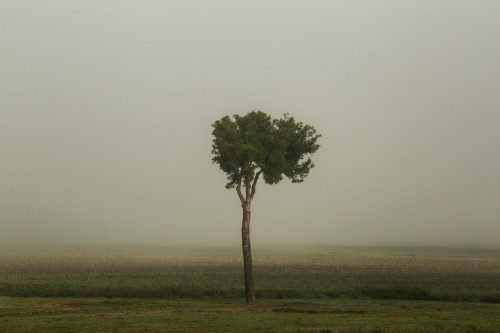Description
OD Photo Prize 2024 | Runner Up
Emilia Martin [b. 1991, Poland] is a photographic artist currently based in the Netherlands. In her work she explores the power of speculation and reimagining of the realities she inhabits. Emilia perceives myths, tales and storytelling to be effective tools for revisioning the past and weaving liveable futures. With the use of speculation and shifting perspectives she revises and constructs personal narratives informed by the intersectional feminist approaches. Her practise primarily consists of the photographic medium but also sound and writing.
Image Description | Image inspired by the story about the Polish sacred folk rocks: Around Poland, in particular the central region from which my ancestors originate, there are traces of huge neolithic rocks that served as spots for collective acts of celebrations, grief, offerings. Those rocks are much older than any dominating religions and political systems, true carers of ancient wisdoms, silent observers, ancestors. When the wave of christianity arrived in the area, the rocks were claimed, based on the statement that they are indeed sacred, but not due to their ancient spiritual role in the communities – “These are the markers of the places where the holy virgin appeared” christians claimed and hired a sculptor to engrave the footprint on the stones. A small, feminine foot, a proof written in stone, manifesting: The virgin took a stand here. Some rocks were moved into churches, built into altars. In one of the villages a priest decided that the rock which served as a central spot for the community, needed to be chopped into pieces and used as a material for building the stairs in the local church. Half of the community agreed to his proposal, but another half opposed. Enraged priest stated that whoever opposes the idea of chopping the rock is opposing christianity (in times when identifying as a non-christian implied hangings or exile). The rock was chopped, the stairs were built. ✴ Digitally altered image found in the public Polish photographic archives.
Artist Statement | “𝘐𝘯 𝘵𝘩𝘦 𝘊𝘢𝘵𝘩𝘰𝘭𝘪𝘤 𝘤𝘩𝘶𝘳𝘤𝘩 𝘵𝘩𝘦𝘳𝘦 𝘢𝘳𝘦 𝘵𝘩𝘳𝘦𝘦 𝘤𝘭𝘢𝘴𝘴𝘦𝘴 𝘰𝘧 𝘳𝘦𝘭𝘪𝘤𝘴. 𝘛𝘩𝘦 𝘧𝘪𝘳𝘴𝘵 𝘤𝘭𝘢𝘴𝘴 𝘪𝘴 𝘣𝘰𝘥𝘺 𝘱𝘢𝘳𝘵𝘴 𝘰𝘧 𝘢 𝘴𝘢𝘪𝘯𝘵. 𝘛𝘩𝘦 𝘴𝘦𝘤𝘰𝘯𝘥 𝘤𝘭𝘢𝘴𝘴 𝘪𝘴 𝘵𝘩𝘪𝘯𝘨𝘴 𝘵𝘩𝘢𝘵 𝘣𝘦𝘭𝘰𝘯𝘨𝘦𝘥 𝘵𝘰 𝘢 𝘴𝘢𝘪𝘯𝘵, 𝘰𝘣𝘫𝘦𝘤𝘵𝘴 𝘵𝘩𝘦𝘺 𝘩𝘢𝘷𝘦 𝘶𝘴𝘦𝘥 𝘢𝘯𝘥 𝘴𝘶𝘳𝘳𝘰𝘶𝘯𝘥𝘦𝘥 𝘵𝘩𝘦𝘮𝘴𝘦𝘭𝘷𝘦𝘴 𝘸𝘪𝘵𝘩. 𝘛𝘩𝘦 𝘵𝘩𝘪𝘳𝘥 𝘤𝘭𝘢𝘴𝘴 𝘳𝘦𝘭𝘪𝘤 𝘪𝘴 𝘵𝘩𝘦 𝘰𝘣𝘫𝘦𝘤𝘵 𝘵𝘩𝘢𝘵 𝘵𝘰𝘶𝘤𝘩𝘦𝘥 𝘵𝘩𝘦 𝘣𝘰𝘥𝘺 𝘰𝘧 𝘢 𝘴𝘢𝘪𝘯𝘵. 𝘛𝘰 𝘤𝘳𝘦𝘢𝘵𝘦 𝘵𝘩𝘦 𝘵𝘩𝘪𝘳𝘥 𝘤𝘭𝘢𝘴𝘴 𝘳𝘦𝘭𝘪𝘤𝘴, 𝘵𝘩𝘦 𝘴𝘮𝘢𝘭𝘭 𝘩𝘰𝘭𝘦𝘴 𝘢𝘳𝘦 𝘥𝘳𝘪𝘭𝘭𝘦𝘥 𝘪𝘯 𝘵𝘩𝘦 𝘵𝘰𝘮𝘣𝘴 𝘰𝘧 𝘴𝘢𝘪𝘯𝘵𝘴. 𝘛𝘩𝘦 𝘰𝘣𝘫𝘦𝘤𝘵𝘴 𝘢𝘳𝘦 𝘭𝘰𝘸𝘦𝘳𝘦𝘥 𝘵𝘩𝘳𝘰𝘶𝘨𝘩 𝘵𝘩𝘦 𝘩𝘰𝘭𝘦𝘴 𝘢𝘯𝘥 𝘰𝘯𝘤𝘦 𝘵𝘩𝘦𝘺 𝘵𝘰𝘶𝘤𝘩 𝘵𝘩𝘦 𝘤𝘰𝘳𝘱𝘴𝘦 𝘵𝘩𝘦𝘺 𝘢𝘳𝘦 𝘯𝘰 𝘭𝘰𝘯𝘨𝘦𝘳 𝘦𝘷𝘦𝘳𝘺𝘥𝘢𝘺 𝘢𝘯𝘥 𝘮𝘶𝘯𝘥𝘢𝘯𝘦 – 𝘵𝘩𝘦𝘺 𝘯𝘰𝘸 𝘣𝘦𝘤𝘰𝘮𝘦 𝘴𝘢𝘤𝘳𝘦𝘥.
Meteorites, boulders, rocks, stones A child-like obsession that began innocently, fueled with curiosity: What stories does a rock whisper?
Ancient mythology is filled with cautionary tales where young, eloquent females were punished for their outspokenness and turned into rocks. A curse of Medusa meant that she transformed anyone she looked at into a rock: mute, passive, motionless and unable to express. Some rocks were believed to be gods, chained to the ground in case they decided to make a return to heavens; celebrated, feared. Some took on central roles in the communities becoming places of worship, grief, sacrifice.
For over two years I have been collecting rock stories. Many of them belong to folk people, such as my ancestors: collectively woven myths that gave ground to caring rituals of relating to space, the land, to one another. Over time these stories fluctuate, gently passed for generations. The longer I give in to my obsession, the more I begin to believe that a rock is not mute at all, but perhaps, the most excellent storyteller of them all.
𝘐 𝘴𝘢𝘸 𝘢 𝘵𝘳𝘦𝘦 𝘣𝘦𝘢𝘳𝘪𝘯𝘨 𝘴𝘵𝘰𝘯𝘦𝘴 𝘪𝘯 𝘵𝘩𝘦 𝘱𝘭𝘢𝘤𝘦 𝘰𝘧 𝘢𝘱𝘱𝘭𝘦𝘴 𝘢𝘯𝘥 𝘱𝘦𝘢𝘳𝘴 is an exploration of a rock as a carrier of stories, a migratory body, a silent, mysterious visitor, filled with projections, dreams and fears. It is an investigation of the myths, stories and rituals and an act of reclaiming them back.“ — Emilia Martin
_
All print enquiries:
tom@opendoors.gallery
+44 (0)7769922824









